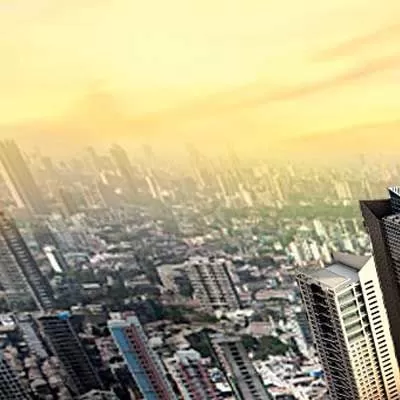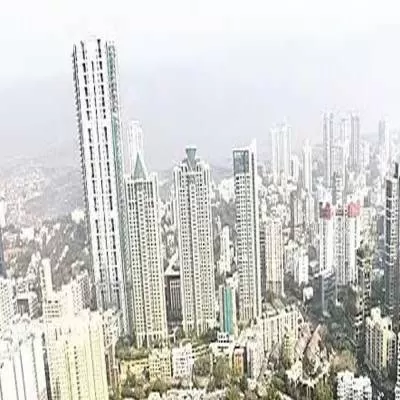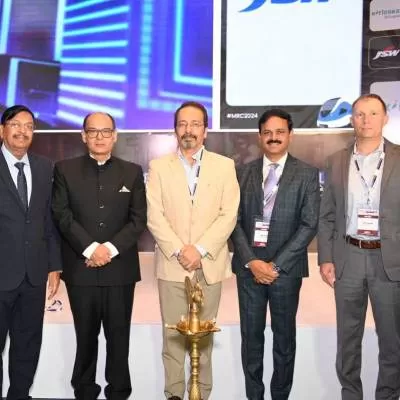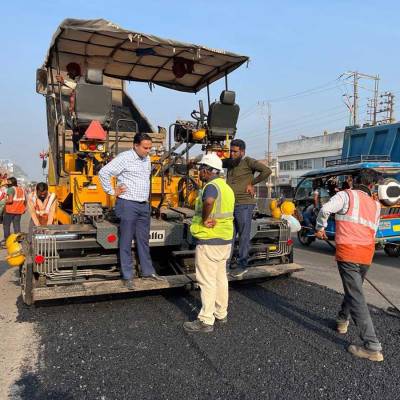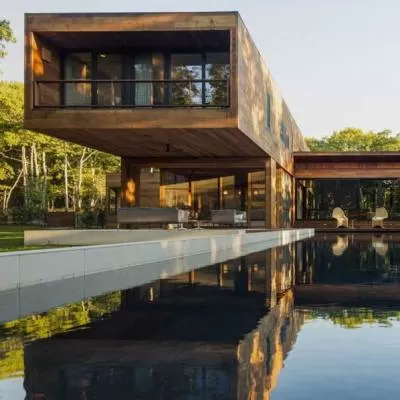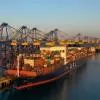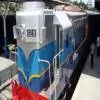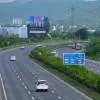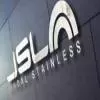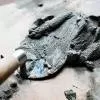- Home
- Real Estate
- Matters of the crown
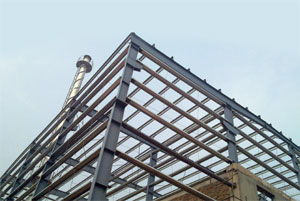
Matters of the crown
Change is in the air in building construction. Most noticeable is the transformation at the top, in the growing demand for "different" sorts of roofing.
Metallic invasion
One of the key trends in roofing is the increasing uptake of metal cladding on the back of growing demand for steel buildings. Gautam Suri, CTO and Founder Director, Interarch Building Products Pvt Ltd, a leading turnkey structural steel company, observes, "Roofing and cladding is witnessing a perception shift as is steel construction. Demand is swinging from clay tiles and conventional roofing systems to metal cladding solutions - particularly for high strength, long-lasting Galvalume® steel panels with optional high performance organic coatings. Demand for steel roofing has grown to about 1 million tonne; it's especially shown good growth in the last three years."
Suri sees this segment growing on the back of increasing demand for urban infrastructure. "Greater awareness about the possibilities of steel would give the industry a boost," he adds. Also, metal buildings are considered green because of their "cleaner" construction modus operandi and because they are amenable to incorporating sufficient insulation to reduce their energy needs. As green building movement gains momentum in India, demand for myriad insulation panels is increasing. Given India's optimal sunny climate, demand for solar panels is poised to spiral as well. Suri sees a genuine case for the country to combat its energy deficit with solar power generating photovoltaic solar roofing panels.
Growing possibilities
As the market for metal buildings expands, demand for metal cladding is evolving. "Demand staples are durability, flexibility, thermal efficiency and aesthetically pleasing designs," says Suri. Amongst the emerging trends, he cites demand for roofs customised as per the building type, size and requirement. Customers are increasingly seeking vendors who can alter sizes and designs to suit their specific needs. In context, Interarch has an advantage in producing all of its roofing systems in limitless lengths with site roll-forming capabilities for all its panels. TRACDEK, its lead product, boasts of long spans and more covered area per unit, which in turn means wide support spacing and more economical supporting structures.
"Also, customers are shifting from conservative screw-down systems to concealed fixed systems wherein sheets are fixed on clips, which in turn are screwed on purlins," observes Suri. It's because concealed fixed systems reduce the chances of leakages. "And demanding customers are looking for innovative architectural solutions in interesting shapes (convex, concave) and in new attractive colours."
Notably, metal buildings first started to be constructed in developed countries about four decades ago. Since then, those countries have seen the concept gradually be adapted for more complex applications. Based on the growing uptake for metal buildings in India, RP Singh, Director, Invogue Building Systems Pvt Ltd expects shopping malls, IT parks, business parks, commercial buildings, airports, stadiums and high rise towers to be constructed using these technologies.
Fast roofs
Vendors of a medley of allied products, such as special insulations and fasteners, are enjoying the flow-on effect of growing demand for metal buildings. Fasteners play a crucial role in enhancing the performance of metal roofing as well as in helping to execute metal building projects with greater efficiency. For instance, Metapps carbon steel fasteners, the premium selling product of Corroshield Fasteners, are well suited for fixing steel sheets into steel substrates. A special feature of the fasteners, Levin Drill Point, enables the fastener to penetrate into steel 30 per cent faster than comparative products. Also, its Scratch Shield protects the body of the fastener from getting scratched while penetrating the metal. If the coating is scraped off, it can lead to premature corrosion and diminish the performance and longevity of metal buildings.
According to Huzefa Abbas, Head of Operations, Asons Enterprise, "Buyers are much better educated nowadays. They aren't content with any zinc coated fastener. They are always on the look out for better products, which can help optimise the performance of the building. Metapps is our lead product; it has been used in steel buildings across India."
Buyers' keen interest is spurring manufacturers of fasteners to introduce new kinds of fasteners boasting of better features than existing ones. Also, Abbas is expecting markets to open up in the coming months and for projects put on hold to see activity. Cold storage and warehousing are two developing markets he is closely watching. This year, Asons Enterprise is reintroducing fasteners for polycarbonate roofing/cladding, albeit in a new design, as well as a new range of fasteners called Timtapps for timber applications.
Aesthetic cladding
Another salient trend in roofing is the increased prioritisation of aesthetic roof cladding delivering additional benefits. One innovative zero maintenance, waterproof and light-weight roofing option is shingles - also a highly aesthetic solution for sloping roofs. Saint Gobain's line of CertainTeed roofing shingles has seen considerable growth across various building segments in India - "particularly from resorts, gated communities, government buildings and individual bungalows," shares Harish V Holalu, Senior Manager, Building Products & Solutions, Saint-Gobain, Grindwell Norton Ltd.
To meet the growing demand and specific needs, the company has recently introduced newer products like "Landmark/Presidential Solaris" range, an energy-star rated, solar - reflecting shingle with special cooling granules to bring down the roof temperature by 25 per cent to 40 per cent and thereby reducing energy costs. This particular range offers the combined advantages of waterproofing and insulation. Other new series, include the "Max Definition" colour series in its "Landmark" range, which offers deeper hues and more contrast in the colour spread; "Presidential Shake" series featuring a unique cross cut pattern designed to mimic a wood-shake appearance and the "Grand Manor" series, the heaviest shingles in the range with a unique shadow line design and random tabs for a slate-like look.
Shingles may entail creating a system of gutters below the eaves of the roof to provide a proper outlet for drain water.
According to Holalu, "This is especially relevant in high rainfall areas and helps in rainwater harvesting. Locally fabricated gutters in aluminium or PVC suit this purpose." Since appli¡cation skills are paramount for the optimum performance of shingles, Saint Gobain offers refresher training to dealers-cum-applicators across India.
"Consisting of both classroom and onsite training, this ensures that applicators skills are continuously updated and therefore, that customers get the actual benefit of this exercise," he adds.
Protective materials
Roof cladding is growing in popularity for aesthetic reasons despite the additional cost it entails. But cladding is best done on a structurally sound roof with watertight joints. It's not a superficial way out for protecting underlying weaknesses in the concrete matrix. If used as such, the cladding materials would eventually weaken.
"Cladding is not a one to one replacement for curative chemicals used to treat weaknesses in the roofing," observes Mangesh Patil, General Manager, Projects, Construction Chemicals Infrastructure Division, Chembond Chemicals Ltd. Waterproofing of roofs is best taken care of during construction though a plethora of crystalline waterproofing, elastomeric waterproofing and moisture curing polyurethane coating products for repair purposes are available.
In keeping with consumers' increasing preference for aesthetics, versatile two-in-one products serving as waterproofing and to enhance the appearance of structures are finding more takers. KEM PROOF 87 is one such product. It is an elastomeric heavy duty waterproof roof coating based on selected acrylic polymers. When applied, it cures to form a durable, protective, waterproof membrane.
It can be applied on concrete, cement board, wood, brick, stone and tiles.
As the market for waterproofing products evolves, products such as membranes are finding more takers as well. "With a waterproofing manufacturing unit in Rajasthan, Texsa India is offering quality APP membranes with fibreglass tissue and polyster reinforcement, membranes with polythene film on both sides as well as granule finished membranes to the Indian market. Such membranes are being manufactured in all thicknesses," says Salil Tuteja, Country Head, Texsa India. Texsa Group manufactures and markets products for roofing/waterproofing, thermal and acoustic insulation and geotextiles, as well as the corresponding auxiliary materials for each of these fields, for building and civil works. After this, Texsa India also plans to manufacture SBS modified torch on and self-adhesive membranes.
Engineering façades
Roofing ties in closely with building façades and with modern architecture. According to KR Suresh, Regional Director at Axis façades Consulting Pvt Ltd, "The advent of double height atriums and air-conditioned indoor spaces has necessitated materials that allow more light to penetrate and possess better thermal properties."
Nowadays, however, façades are about more than aesthetics and protection from adverse climatic conditions - they are a means to optimise the energy consumption of buildings. Rohan Keswani, Director, Aluplex India, sees a strong trend towards glass facades, large atriums and skylights, which is spurring demand for low emissivity coated glass. "Essentially atriums and skylights allow natural light to enter the building, thereby minimising the need for artificial lighting. Getting the direction of the glass fatade and the angle of the skylight roof glass right can also minimise direct heat radiation entering the building, which in turn cuts down on air-conditioning requirements. Low emissivity glass allows electromagnetic waves of the visible spectrum of light to enter the building but reflects heat-causing ultraviolet and infrared waves, thus reducing overall energy requirements," he explains.
Another salient development is the growing popularity of sun-shaded glass façades, which can be achieved with louvers covering the glass (such as Platina in Bandra Kurla Complex) or with sun-shades made of aluminium or even stone and granite.
With the height of newly launched building projects rising from 20 stories to 45 storey buildings and even to 65 storey towers, Keswani expects demand for energy efficient fatade engineering products to increase.
"As demand for structures delivering high value increases, demand for quality products engineered for façades will also rise. Buildings with media façades and complex geometry façades incorporating efficient lighting features are gradually becoming more popular."
Variant roofs
Laminated glass is by far the most popular choice for skylights and roofs in India. "But glass raises issues such as glare, heat penetration, dust accumulation and safety. Certainly, laminated insulated glass with ceramic frit can mitigate the heat, glare and safety issues in skylights. But, this tends to increase the weight of the structural members, which invariably does not satisfy architects requirements," observes Suresh.
One solution to these pressing concerns emerged as polycarbonate extruded multiwall sheets - a light material necessitating minimalist lightweight steel substructures.
"Its disadvantage is that it cannot replace the seamless glass affect and also poses restrictions in the width of the panels. Also, though its thermal properties are at par with glass, it required some improvisation in terms of energy saving and ventilation," continues Suresh.
Now developers have the choice of improvised materials that can be stretched, which can resist abrasion, and offer better light transmission and thermal properties. Suresh cites Kalwall, PTFE (polytetra fluoroethylene) and ETFE (ethylene tetrafluoroethylene) as three emerging roofing options.
Of these, Kalwall is a superior structural composite sandwich panel formed by permanently bonding, under heat and pressure, specially formulated, fibreglass-reinforced translucent faces to a grid core constructed of interlocked, structural aluminium/composite, thermally broken "I" beams. The panels can be curved or flat, 2-3/4 inches (70 mm) or 4 inches (100 mm) thick.
Tensile fibre roofs
PTFE, fibreglass coated with teflon, and ETFE, a fluorine-based plastic, what is highly corrosion resistant and strong over a wide temperature range, are classified as tensile fibre roofs. Tensile fabric is useful in many applications, albeit its uptake is still sluggish in India. Greater awareness about the longevity of the "fabric" would help to grow takers. According to Singh, "The word 'fabric' tends to create some doubt about the strength of the roofing. Actually, imported fabric has a clear life of more than 10 years and is extremely aesthetic. Many covered stadiums constructed for the Common Wealth Games had tensile fabric roofs. It is ideally suited for commercial applications such as toll bridges, canopies, car parks and outdoor areas in hotels. PTFE has been extensively used in India for infra projects like stadiums and airports. "Its salient disadvantage is that it does not allow for visible light transmission (VLT) above 45 per cent as compared to glass, so it is best used only as a shading device. Indian climatic conditions need skylights or roofs to cut down the heat in addition to the light and safety. Also, PTFE mandates ventilation if it's used for enclosed spaces," adds Suresh.
Suresh sees a bright future for ETFE, which offers significant advantages such as high VLT, strength, high tensile strength, better U-value and shading coefficient (when inflated) and better sound transmission control values. Also, it's amenable to roofing as it is prone to punctures by sharp edges. ETFE has been successfully used for the skylight of the Sahara Star hotel in Mumbai.
Of course, budgetary constraints remain but Suresh feels that clients who understand the advantages of the material vis-a-vis the cost will press ahead with the better choice. Plus, per square foot pricing for these systems is bound to come down in future, which bodes well for roofing applications.
Façade engineering at its best
• A few innovative façade engineering projects in Mumbai by Aluplex India Pvt Ltd ICICI Bank's façade demonstrates the use of low energy glass.
• The building of the National Stock Exchange of India Ltd features a skylight and boasts of a complex geometry façade with low emissivity glass.
• CRISIL House features a skylight and an open atrium covered with high performance glass to permit natural sunlight to penetrate and curb air-conditioning costs.
• A curved elliptical façade with media lighting adorns Century Bhavan.
• Godrej's headquarters feature a state-of-the-art façade with bolted glazing, an atrium with an inclined roof skylight and ceramic stone panels for sun-shading, appropriate lighting and energy conservation. The architect of Godrej One is Pelli Clarke Pelli Architects of USA.
To share your views on the Roofing and Cladding industry, write in at feedback@ASAPPmedia.com
'Top' matters are gaining importance in the construction of buildings, and trending towards newer preferences. Change is in the air in building construction. Most noticeable is the transformation at the top, in the growing demand for "different" sorts of roofing. Metallic invasion One of the key trends in roofing is the increasing uptake of metal cladding on the back of growing demand for steel buildings. Gautam Suri, CTO and Founder Director, Interarch Building Products Pvt Ltd, a leading turnkey structural steel company, observes, "Roofing and cladding is witnessing a perception shift as is steel construction. Demand is swinging from clay tiles and conventional roofing systems to metal cladding solutions - particularly for high strength, long-lasting Galvalume® steel panels with optional high performance organic coatings. Demand for steel roofing has grown to about 1 million tonne; it's especially shown good growth in the last three years." Suri sees this segment growing on the back of increasing demand for urban infrastructure. "Greater awareness about the possibilities of steel would give the industry a boost," he adds. Also, metal buildings are considered green because of their "cleaner" construction modus operandi and because they are amenable to incorporating sufficient insulation to reduce their energy needs. As green building movement gains momentum in India, demand for myriad insulation panels is increasing. Given India's optimal sunny climate, demand for solar panels is poised to spiral as well. Suri sees a genuine case for the country to combat its energy deficit with solar power generating photovoltaic solar roofing panels. Growing possibilities As the market for metal buildings expands, demand for metal cladding is evolving. "Demand staples are durability, flexibility, thermal efficiency and aesthetically pleasing designs," says Suri. Amongst the emerging trends, he cites demand for roofs customised as per the building type, size and requirement. Customers are increasingly seeking vendors who can alter sizes and designs to suit their specific needs. In context, Interarch has an advantage in producing all of its roofing systems in limitless lengths with site roll-forming capabilities for all its panels. TRACDEK, its lead product, boasts of long spans and more covered area per unit, which in turn means wide support spacing and more economical supporting structures. "Also, customers are shifting from conservative screw-down systems to concealed fixed systems wherein sheets are fixed on clips, which in turn are screwed on purlins," observes Suri. It's because concealed fixed systems reduce the chances of leakages. "And demanding customers are looking for innovative architectural solutions in interesting shapes (convex, concave) and in new attractive colours." Notably, metal buildings first started to be constructed in developed countries about four decades ago. Since then, those countries have seen the concept gradually be adapted for more complex applications. Based on the growing uptake for metal buildings in India, RP Singh, Director, Invogue Building Systems Pvt Ltd expects shopping malls, IT parks, business parks, commercial buildings, airports, stadiums and high rise towers to be constructed using these technologies. Fast roofs Vendors of a medley of allied products, such as special insulations and fasteners, are enjoying the flow-on effect of growing demand for metal buildings. Fasteners play a crucial role in enhancing the performance of metal roofing as well as in helping to execute metal building projects with greater efficiency. For instance, Metapps carbon steel fasteners, the premium selling product of Corroshield Fasteners, are well suited for fixing steel sheets into steel substrates. A special feature of the fasteners, Levin Drill Point, enables the fastener to penetrate into steel 30 per cent faster than comparative products. Also, its Scratch Shield protects the body of the fastener from getting scratched while penetrating the metal. If the coating is scraped off, it can lead to premature corrosion and diminish the performance and longevity of metal buildings. According to Huzefa Abbas, Head of Operations, Asons Enterprise, "Buyers are much better educated nowadays. They aren't content with any zinc coated fastener. They are always on the look out for better products, which can help optimise the performance of the building. Metapps is our lead product; it has been used in steel buildings across India." Buyers' keen interest is spurring manufacturers of fasteners to introduce new kinds of fasteners boasting of better features than existing ones. Also, Abbas is expecting markets to open up in the coming months and for projects put on hold to see activity. Cold storage and warehousing are two developing markets he is closely watching. This year, Asons Enterprise is reintroducing fasteners for polycarbonate roofing/cladding, albeit in a new design, as well as a new range of fasteners called Timtapps for timber applications. Aesthetic cladding Another salient trend in roofing is the increased prioritisation of aesthetic roof cladding delivering additional benefits. One innovative zero maintenance, waterproof and light-weight roofing option is shingles - also a highly aesthetic solution for sloping roofs. Saint Gobain's line of CertainTeed roofing shingles has seen considerable growth across various building segments in India - "particularly from resorts, gated communities, government buildings and individual bungalows," shares Harish V Holalu, Senior Manager, Building Products & Solutions, Saint-Gobain, Grindwell Norton Ltd. To meet the growing demand and specific needs, the company has recently introduced newer products like "Landmark/Presidential Solaris" range, an energy-star rated, solar - reflecting shingle with special cooling granules to bring down the roof temperature by 25 per cent to 40 per cent and thereby reducing energy costs. This particular range offers the combined advantages of waterproofing and insulation. Other new series, include the "Max Definition" colour series in its "Landmark" range, which offers deeper hues and more contrast in the colour spread; "Presidential Shake" series featuring a unique cross cut pattern designed to mimic a wood-shake appearance and the "Grand Manor" series, the heaviest shingles in the range with a unique shadow line design and random tabs for a slate-like look. Shingles may entail creating a system of gutters below the eaves of the roof to provide a proper outlet for drain water. According to Holalu, "This is especially relevant in high rainfall areas and helps in rainwater harvesting. Locally fabricated gutters in aluminium or PVC suit this purpose." Since appli¡cation skills are paramount for the optimum performance of shingles, Saint Gobain offers refresher training to dealers-cum-applicators across India. "Consisting of both classroom and onsite training, this ensures that applicators skills are continuously updated and therefore, that customers get the actual benefit of this exercise," he adds. Protective materials Roof cladding is growing in popularity for aesthetic reasons despite the additional cost it entails. But cladding is best done on a structurally sound roof with watertight joints. It's not a superficial way out for protecting underlying weaknesses in the concrete matrix. If used as such, the cladding materials would eventually weaken. "Cladding is not a one to one replacement for curative chemicals used to treat weaknesses in the roofing," observes Mangesh Patil, General Manager, Projects, Construction Chemicals Infrastructure Division, Chembond Chemicals Ltd. Waterproofing of roofs is best taken care of during construction though a plethora of crystalline waterproofing, elastomeric waterproofing and moisture curing polyurethane coating products for repair purposes are available. In keeping with consumers' increasing preference for aesthetics, versatile two-in-one products serving as waterproofing and to enhance the appearance of structures are finding more takers. KEM PROOF 87 is one such product. It is an elastomeric heavy duty waterproof roof coating based on selected acrylic polymers. When applied, it cures to form a durable, protective, waterproof membrane. It can be applied on concrete, cement board, wood, brick, stone and tiles. As the market for waterproofing products evolves, products such as membranes are finding more takers as well. "With a waterproofing manufacturing unit in Rajasthan, Texsa India is offering quality APP membranes with fibreglass tissue and polyster reinforcement, membranes with polythene film on both sides as well as granule finished membranes to the Indian market. Such membranes are being manufactured in all thicknesses," says Salil Tuteja, Country Head, Texsa India. Texsa Group manufactures and markets products for roofing/waterproofing, thermal and acoustic insulation and geotextiles, as well as the corresponding auxiliary materials for each of these fields, for building and civil works. After this, Texsa India also plans to manufacture SBS modified torch on and self-adhesive membranes. Engineering façades Roofing ties in closely with building façades and with modern architecture. According to KR Suresh, Regional Director at Axis façades Consulting Pvt Ltd, "The advent of double height atriums and air-conditioned indoor spaces has necessitated materials that allow more light to penetrate and possess better thermal properties." Nowadays, however, façades are about more than aesthetics and protection from adverse climatic conditions - they are a means to optimise the energy consumption of buildings. Rohan Keswani, Director, Aluplex India, sees a strong trend towards glass facades, large atriums and skylights, which is spurring demand for low emissivity coated glass. "Essentially atriums and skylights allow natural light to enter the building, thereby minimising the need for artificial lighting. Getting the direction of the glass fatade and the angle of the skylight roof glass right can also minimise direct heat radiation entering the building, which in turn cuts down on air-conditioning requirements. Low emissivity glass allows electromagnetic waves of the visible spectrum of light to enter the building but reflects heat-causing ultraviolet and infrared waves, thus reducing overall energy requirements," he explains. Another salient development is the growing popularity of sun-shaded glass façades, which can be achieved with louvers covering the glass (such as Platina in Bandra Kurla Complex) or with sun-shades made of aluminium or even stone and granite. With the height of newly launched building projects rising from 20 stories to 45 storey buildings and even to 65 storey towers, Keswani expects demand for energy efficient fatade engineering products to increase. "As demand for structures delivering high value increases, demand for quality products engineered for façades will also rise. Buildings with media façades and complex geometry façades incorporating efficient lighting features are gradually becoming more popular." Variant roofs Laminated glass is by far the most popular choice for skylights and roofs in India. "But glass raises issues such as glare, heat penetration, dust accumulation and safety. Certainly, laminated insulated glass with ceramic frit can mitigate the heat, glare and safety issues in skylights. But, this tends to increase the weight of the structural members, which invariably does not satisfy architects requirements," observes Suresh. One solution to these pressing concerns emerged as polycarbonate extruded multiwall sheets - a light material necessitating minimalist lightweight steel substructures. "Its disadvantage is that it cannot replace the seamless glass affect and also poses restrictions in the width of the panels. Also, though its thermal properties are at par with glass, it required some improvisation in terms of energy saving and ventilation," continues Suresh. Now developers have the choice of improvised materials that can be stretched, which can resist abrasion, and offer better light transmission and thermal properties. Suresh cites Kalwall, PTFE (polytetra fluoroethylene) and ETFE (ethylene tetrafluoroethylene) as three emerging roofing options. Of these, Kalwall is a superior structural composite sandwich panel formed by permanently bonding, under heat and pressure, specially formulated, fibreglass-reinforced translucent faces to a grid core constructed of interlocked, structural aluminium/composite, thermally broken "I" beams. The panels can be curved or flat, 2-3/4 inches (70 mm) or 4 inches (100 mm) thick. Tensile fibre roofs PTFE, fibreglass coated with teflon, and ETFE, a fluorine-based plastic, what is highly corrosion resistant and strong over a wide temperature range, are classified as tensile fibre roofs. Tensile fabric is useful in many applications, albeit its uptake is still sluggish in India. Greater awareness about the longevity of the "fabric" would help to grow takers. According to Singh, "The word 'fabric' tends to create some doubt about the strength of the roofing. Actually, imported fabric has a clear life of more than 10 years and is extremely aesthetic. Many covered stadiums constructed for the Common Wealth Games had tensile fabric roofs. It is ideally suited for commercial applications such as toll bridges, canopies, car parks and outdoor areas in hotels. PTFE has been extensively used in India for infra projects like stadiums and airports. "Its salient disadvantage is that it does not allow for visible light transmission (VLT) above 45 per cent as compared to glass, so it is best used only as a shading device. Indian climatic conditions need skylights or roofs to cut down the heat in addition to the light and safety. Also, PTFE mandates ventilation if it's used for enclosed spaces," adds Suresh. Suresh sees a bright future for ETFE, which offers significant advantages such as high VLT, strength, high tensile strength, better U-value and shading coefficient (when inflated) and better sound transmission control values. Also, it's amenable to roofing as it is prone to punctures by sharp edges. ETFE has been successfully used for the skylight of the Sahara Star hotel in Mumbai. Of course, budgetary constraints remain but Suresh feels that clients who understand the advantages of the material vis-a-vis the cost will press ahead with the better choice. Plus, per square foot pricing for these systems is bound to come down in future, which bodes well for roofing applications. Façade engineering at its best • A few innovative façade engineering projects in Mumbai by Aluplex India Pvt Ltd ICICI Bank's façade demonstrates the use of low energy glass. • The building of the National Stock Exchange of India Ltd features a skylight and boasts of a complex geometry façade with low emissivity glass. • CRISIL House features a skylight and an open atrium covered with high performance glass to permit natural sunlight to penetrate and curb air-conditioning costs. • A curved elliptical façade with media lighting adorns Century Bhavan. • Godrej's headquarters feature a state-of-the-art façade with bolted glazing, an atrium with an inclined roof skylight and ceramic stone panels for sun-shading, appropriate lighting and energy conservation. The architect of Godrej One is Pelli Clarke Pelli Architects of USA. To share your views on the Roofing and Cladding industry, write in at feedback@ASAPPmedia.com





